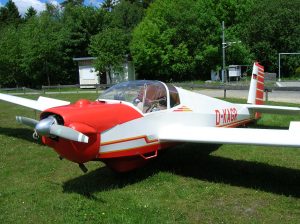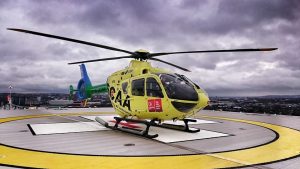A SCOTTISH charity air ambulance could be fitted with a collision detection system following a near-miss with a glider.
The Scotland’s Charity Air Ambulance (SCAA) chopper spotted the motorised glider “at the last minute” and took evasive action on March 25.
The SCAA pilot had just dropped a patient off at a hospital in Glasgow and was flying at a height of 2,700ft near its base at Perth Airport when the incident happened.
The pilot failed to spot the red and white glider – thought to be a Schiebe-Falke SF25 with a wingspan of over 50ft – due to it being obscured by the chopper’s windscreen pillar.
Luckily the pilot managed to pull to the right just in time to avoid the near miss – passing the glider by just 200 metres.

UKAB listed the severity of the incident as having a “B listed risk” – the second most serious – stating “Safety not assured: aircraft proximity in which the safety of the aircraft may have been compromised.”
The near miss resulted in the UK Airprox Board (UKAB) launching an investigation and questioning why a collision warning system (CWS) was not fitted.
In a report, released yesterday (MON), the UKAB blamed the cause of incident on the late sighting by the SCAA pilot.
They said that members of the board noted that the helicopter was not fitted with a CWS.
The report stated that “given the likelihood of encountering gliders during their tasking, some members wondered whether the operating authority had considered fitting a FLARM- compatible CWS or similar”.
The report added: “See-and-avoid was the [helicopter] pilot’s only mitigation against mid-air collision, and the fact that he was conducting his arrival checks had understandably reduced his and his crewman’s capacity for robust and effective look-out.
“That being said, although it was a late sighting, he did see the other aircraft in time to take avoiding action, albeit achieving less separation than would be desirable.”
Members from UKAB revealed they were unable to trace the glider pilot, despite contacting local gliding clubs in the area.
The charity said today that despite collision warning systems not being mandatory, installation of the device would be discussed at a meeting to discuss the report this week.

David Craig, SCAA’s chief executive, said: “We are currently reviewing the report and the observations and recommendations contained within it.
“I am meeting with our aviation providers – Babcock Mission Critical Services (Onshore) Ltd, later this week to determine what steps, if any, we should be taking in response to the incident and the report findings.”
Scotland’s Charity Air Ambulance launched on 22nd May 2013 and from their base at Perth Airport the team reach 90% of Scotland’s population within 25 minutes.
They fly to time-critical emergencies across Scotland and are funded on donations by supporters.
So far they have attended 1469 time critical emergency call outs.

